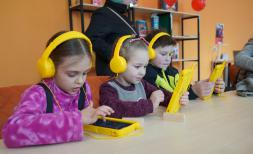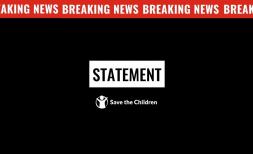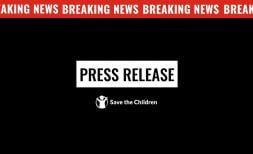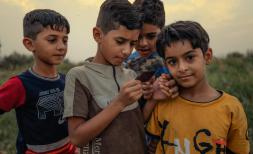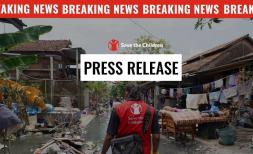Protection of children persistently underfunded in humanitarian responses

As the world’s leaders today meet in New York to review and assess progress on the commitments they have made to end violence against children, a new report reveals huge funding gaps for child protection – leaving children in humanitarian crises unprotected from violence, abuse, neglect and exploitation.
Although the number of children living in conflict affected areas has almost doubled since 1990, and the verified grave violations against children has almost tripled since 2010, activities that aim to increase the protection of children in humanitarian settings remain alarmingly underfunded.
A new study undertaken by Save the Children on behalf of The Alliance for Child Protection in Humanitarian Action and the Child Protection Area of Responsibility, finds that on average, a mere 0,5 % of total humanitarian funding is allocated to child protection activities. The report “Unprotected: Crisis in Humanitarian Funding for Child Protection”is a desk review of the total global humanitarian funding allocated to child protection between 2010 and 2018, with in-depth studies of 13 conflict affected countries, including Syria, Yemen, Iraq and Afghanistan. The study finds that although the overall humanitarian funding has increased over the last decade, including the funding allocated to child protection interventions, the need for child protection interventions has increased even more. In countries like Afghanistan and the Central African Republic, only 18 % and 25 % of the funding requirements for child protection were met in 2018.
“The world’s leaders are gathered today in New York for the high-level political forum on sustainable development to address the question of what key interventions can help reach the furthest behind first, especially those who are left behind due to violence, injustice and exclusion. This report is a timely wake-up call for the leaders to take immediate action to prevent violations of children’s rights, and respond to the urgent need for protection, including mental health and psycho-social support, family tracing and reunification, recovery and reintegration”, says Gunvor Knag Fylkesnes, Advocacy Director for Save the Children Norway.
Child protection is defined as the prevention and response to abuse, neglect, exploitation of children and violence against children. “In practical terms, this means a range of different activities such as preventing recruitment and use of children by armed forces and groups and supporting children’s reintegration into their families and communities. We also advocate for ending attacks on schools and hospitals, providing quality mental health and psycho-social services, preventing family separation and reunifying children who are separated. Activities also include safe spaces for children in emergencies, and case management for the most vulnerable and children at risk”, says Hani Mansourian from the Alliance for Child Protection in Humanitarian Action.
The thousands of children traced and reunited with their families in South Sudan are some of many examples of effective child protection interventions. Reuniting children with their families is perhaps the most effective way of protecting them.
“The negligible funding to this sector indicates a lack of awareness and recognition that child protection activities in emergencies are life-saving and urgent,” adds Michael Copland from the Child Protection Area of Responsibility.
The study finds that funding for child protection falls extremely short of the needs. Child protection consists of various activities and cost estimations vary between regions and local context. But the study finds that to provide high quality case management with referral to service provision and restoring family links, an average of US$ 800 is needed per child.
The report calls on donors to bolster the funding to child protection activities from 0,5 % to at least 4 % of total humanitarian funding to start closing this gap (see graph below). The report also calls on humanitarian actors to prioritize child protection activities in their funding requests and humanitarian appeals.
“Both humanitarian actors and donors must step up to their commitment to reaching the furthest behind: children who are left unprotected from harm in humanitarian crises. At the end of the day, our humanity is measured by how we treat our children, the most vulnerable among us. Today, one in five children live in conflict affected settings, and they depend on us to take joint and immediate action to protect them from grave violations of their rights”, says Knag Fylkesnes.
Note to editor:
Graph visualising the funding gap in child protection is attached.
The Alliance for Child Protection in Humanitarian Action is a global, interagency group that sets standards and provide technical support to ensure that efforts to protect children from violence and exploitation are of high quality and effective.
The Child Protection Area of Responsibility (CP AoR) is specifically focused on enhancing child protection coordination and response in humanitarian contexts (as defined as Humanitarian Coordinator and Early Warning contexts). CP AoR ensures that the efforts of national and international actors to protect children are well coordinated, achieving maximum quality and impact.
Contacts and spokespeople:
Alison Sutton, Global Director Child Protection, Save the Children alison.sutton@savethechildren.org/+44 7391 408249 (London)
Hani Mansourian, Co-Coordinator, The Alliance for Child Protection in Humanitarian Action Hani.mansourian@alliancecpha.org | Nairobi: +254 900 981 (Nairobi)
Michael Copland, Coordinator, Global Child Protection AoR, mcoplan@unicef.org/+41 79 515 29 58 (Geneva)
Laila Khondkar, Head of Advocacy and Policy, Child Protection, Program Quality and Impact, Save the Children laila.khondkar@savethechildren.org/+ 44 (0) 7768487571 (New York)
Alvhild Strømme, Media Manager Save the Children, alvhild.stromme@reddbarna.no /+47 971 92 777 (in Oslo)
